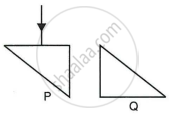Advertisements
Advertisements
Question
Images formed by totally reflecting prisms are brighter than the image formed by ordinary reflected light, why?
Solution
This is because in total internal reflection 100% of incident light gets reflected. On the other hand, in ordinary reflection, 20% to 30% of incident light is lost. So, images formed in the first case are brighter than the images formed in the second case.
APPEARS IN
RELATED QUESTIONS
You are given prisms made of crown glass and flint glass with a wide variety of angles. Suggest a combination of prisms which will
(a) deviate a pencil of white light without much dispersion,
(b) disperse (and displace) a pencil of white light without much deviation.
Two isosceles right-angle glass prisms P and Q are placed near each other as shown in Fig. Complete the path of the light ray entering the prism P till it emerges out of the prism Q.

Solve the previous problem if the paperweight is inverted at its place so that the spherical surface touches the paper.
Plot a graph between
Angle of incidence versus angle of reflection,
If a light ray does not undergo, refraction at the boundary between two media, the angle of incidence is:
How does a ray of light bend when it travels from rarer to denser medium
State two advantages of using a right-angle prism as a reflector, rather than a plane mirror.
Solve Numerical example.
A monochromatic ray of light is incident at 37° on an equilateral prism of refractive index 3/2. Determine angle of emergence and angle of deviation. If angle of prism is adjustable, what should its value be for emergent rays to be just possible for the same angle of incidence?
Which one of the following is NOT the correct formula for refractive index of glass w.r.t. air (aμg) (i = angle of incidence, r = angle of refraction)
The critical angle is defined as the angle of incidence at which the total internal reflection starts to occur.
